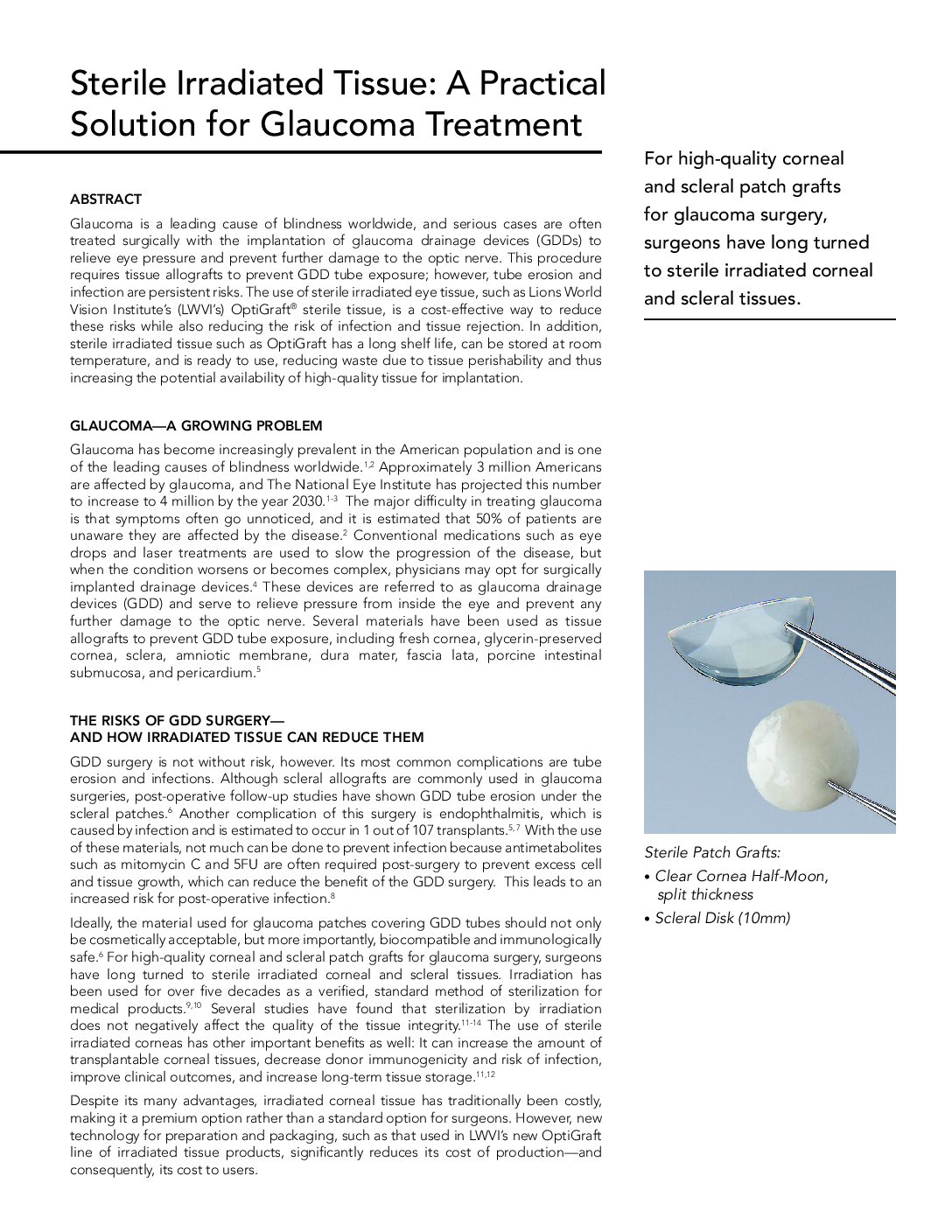Sterile Irradiated Tissue: A Practical Solution for Glaucoma Treatment
Download: Sterile Irradiated Tissue: A Practical Solution for Glaucoma Treatment
A sample of content in this file:
Sterile Irradiated Tissue: A Practical Solution for Glaucoma Treatment
ABSTRACT
Glaucoma is a leading cause of blindness worldwide, and serious cases are often treated surgically with the implantation of glaucoma drainage devices (GDDs) to relieve eye pressure and prevent further damage to the optic nerve. This procedure requires tissue allografts to prevent GDD tube exposure; however, tube erosion and infection are persistent risks. The use of sterile irradiated eye tissue, such as Lions World Vision Institute’s (LWVI’s) OptiGraft® sterile tissue, is a cost-effective way to reduce these risks while also reducing the risk of infection and tissue rejection. In addition, sterile irradiated tissue such as OptiGraft has a long shelf life, can be stored at room temperature, and is ready to use, reducing waste due to tissue perishability and thus increasing the potential availability of high-quality tissue for implantation.
GLAUCOMA—A GROWING PROBLEM
Glaucoma has become increasingly prevalent in the American population and is one of the leading causes of blindness worldwide.1,2 Approximately 3 million Americans are affected by glaucoma, and The National Eye Institute has projected this number to increase to 4 million by the year 2030.1-3 The major difficulty in treating glaucoma is that symptoms often go unnoticed, and it is estimated that 50% of patients are unaware they are affected by the disease.2 Conventional medications such as eye drops and laser treatments are used to slow the progression of the disease, but when the condition worsens or becomes complex, physicians may opt for surgically implanted drainage devices.4 These devices are referred to as glaucoma drainage devices (GDD) and serve to relieve pressure from inside the eye and prevent any further damage to the optic nerve. Several materials have been used as tissue allografts to prevent GDD tube exposure, including fresh cornea, glycerin-preserved cornea, sclera, amniotic membrane, dura mater, fascia lata, porcine intestinal submucosa, and pericardium.5
THE RISKS OF GDD SURGERY— AND HOW IRRADIATED TISSUE CAN REDUCE THEM
GDD surgery is not without risk, however. Its most common complications are tube erosion and infections. Although scleral allografts are commonly used in glaucoma surgeries, post-operative follow-up studies have shown GDD tube erosion under the scleral patches.6 Another complication of this surgery is endophthalmitis, which is caused by infection and is estimated to occur in 1 out of 107 transplants.5, 7 With the use of these materials, not much can be done to prevent infection because antimetabolites such as mitomycin C and 5FU are often required post-surgery to prevent excess cell and tissue growth, which can reduce the benefit of the GDD surgery. This leads to an increased risk for post-operative infection.8
Ideally, the material used for glaucoma patches covering GDD tubes should not only be cosmetically acceptable, but more importantly, biocompatible and immunologically safe.6 For high-quality corneal and scleral patch grafts for glaucoma surgery, surgeons have long turned to sterile irradiated corneal and scleral tissues. Irradiation has been used for over five decades as a verified, standard method of sterilization for medical products.9,10 Several studies have found that sterilization by irradiation does not negatively affect the quality of the tissue integrity.11-14 The use of sterile irradiated corneas has other important benefits as well: It can increase the amount of transplantable corneal tissues, decrease donor immunogenicity and risk of infection, improve clinical outcomes, and increase long-term tissue storage.11,12
Despite its many advantages, irradiated corneal tissue has traditionally been costly, making it a premium option rather than a standard option for surgeons. However, new technology for preparation and packaging, such as that used in LWVI’s new OptiGraft line of irradiated tissue products, significantly reduces its cost of production—and consequently, its cost to users.

